The austere, grand site of Hampi in Karnataka, India, was the prosperous capital of the Vijayanagara Empire. For over 200 years its fabulously rich princes built temples and palaces admired by Persian and European travelers. Despite being conquered, pillaged and destroyed in 1565ce, many ruins remain partially intact. In our feature story we visit temples including still-functioning Virupaksha, palace monuments and adjacent verdant river basins.
By Padma Krishnan and Anne Petry
India is so rich in terms of historical and religious sites that it is not easy to choose which of these incredible places to visit. One day when I was traveling in South India, several people told me about Hampi, describing it with words like great, spectacular, glorious, majestic, outstanding, amazing. Intrigued by a place that accumulates so many superlatives, I had to go there and see for myself. Once there, I quickly realized that Hampi was all this and much more. Visiting this ancient capital is not only to take in the sights, it is also to take in the heart! So, put on your virtual hiking shoes, or if you prefer, get on your bike, and together discover this architectural jewel located in a breathtaking natural environment.
For those who travel in the south Indian state of Karnataka, Hampi is a must! Classified as a UNESCO World Heritage Site, it includes more than 1,600 ruins spread across more than 15 square miles. In 2012, under UNESCO’S jurisdiction, dozens of houses, small stores, restaurants and guest houses built on ancient relics located near the main alley and Virupaksha Temple were demolished, forcing about 300 squatting families to move out and find another place to live and work. The misery of some made for the happiness of others, especially those interested in archeology. If today many statues still remain enigmatic, research and excavations have uncovered one of the most fascinating sites in the country.
Myth and History of Hampi
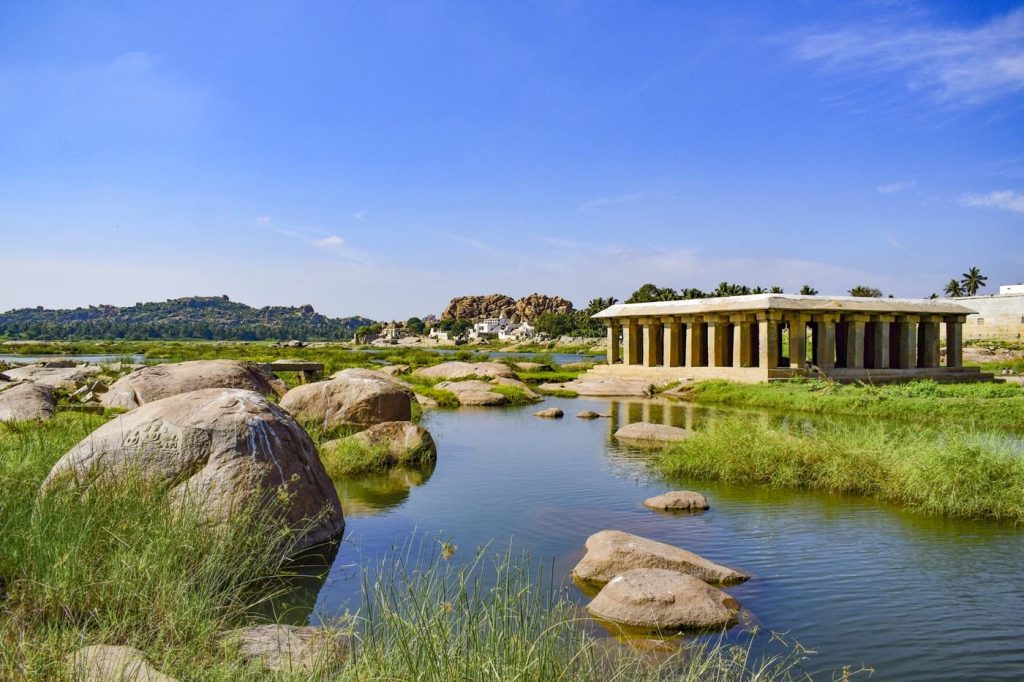

While I could have visited Hampi on my own with a simple travel book to get the main historical information, I figured that if any place deserved a more in-depth explanation, it was this one. It didn’t take me long to find Deepak, a local affable professional guide who is passionate about the region. Let me tell you the story he shared with intensity.
As often in India, legends merge with history, and Hampi is no exception to the rule. The myth tells that the Lord of Love, Manmatha, reaching the river Pampa, disturbed Siva who was meditating on the Hemakuta Hill. Manmatha was burnt to ashes by the fire of Siva’s third eye. Later Lord Siva married Pampa, the river Goddess, an avatar of Parvati, and Manmatha was forgiven and resurrected. In ancient days, this holy site was called Pampakshetra, and locals celebrated the divine wedding annually. The Virupaksha Temple was built here and Pampakshetra became a major Saivite pilgrimage site. Over time, the Virupaksha Temple became the center of the Vijayanagara Empire, and the sacred core of the majestic Vijayanagara, now known as Hampi.
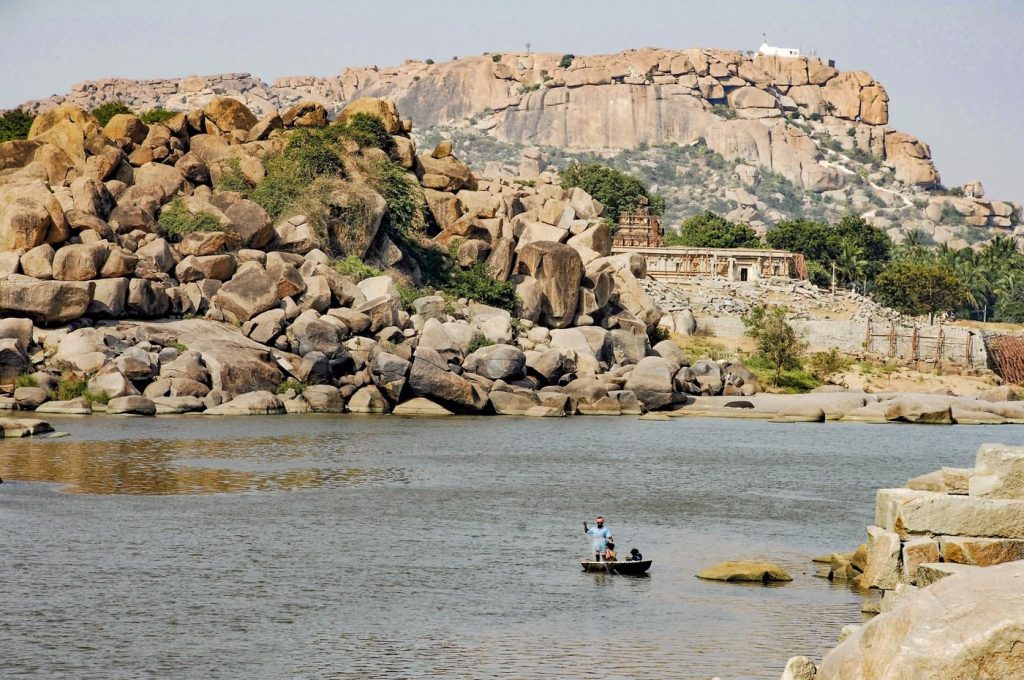





On a historical level, the Sangama brothers, founders of the Vijayanagara dynasty, chose their capital city wisely. The site is bordered by the mountains Anjaneya, Malyavanta and the Matanga Hills on three sides, with the Tungabhadra River on the fourth. The hills provided formidable defences against hostile attacks, and the river formed a natural border. The fertile Tungabhadra river basins assured food production, and the hill stones were prime resources for building a new city. They built it beautifully and called it Vijayanagara, City of Victory.
Though long forgotten and almost erased from history, Vijayanagara was, in the 15th century, the second largest city in the world after Beijing, with up to half a million inhabitants, a very large population for the time. Vijayanagara was so important that the dynasty of the builder kings was able to maintain its power over all Southern India for over two centuries.
It took two centuries to build the city. The seven-layered fortifications, temples, palaces, markets, mandapas (pillared pavilions), gardens and waterworks demanded strong leadership and the availability of continuous talent. For generations, artists trained on the hills of Hemakuta and Matanga, where you can still find the stonework of their apprentices. Hampi’s magnificent stone art was crafted with patient dedication and talent. Hampi demonstrates the skill and vast knowledge of the people who inhabited it. They were experts in architecture, hydraulics, defense, mythology, music, civics, painting, planning and building megastructures.
A Leap into the Past
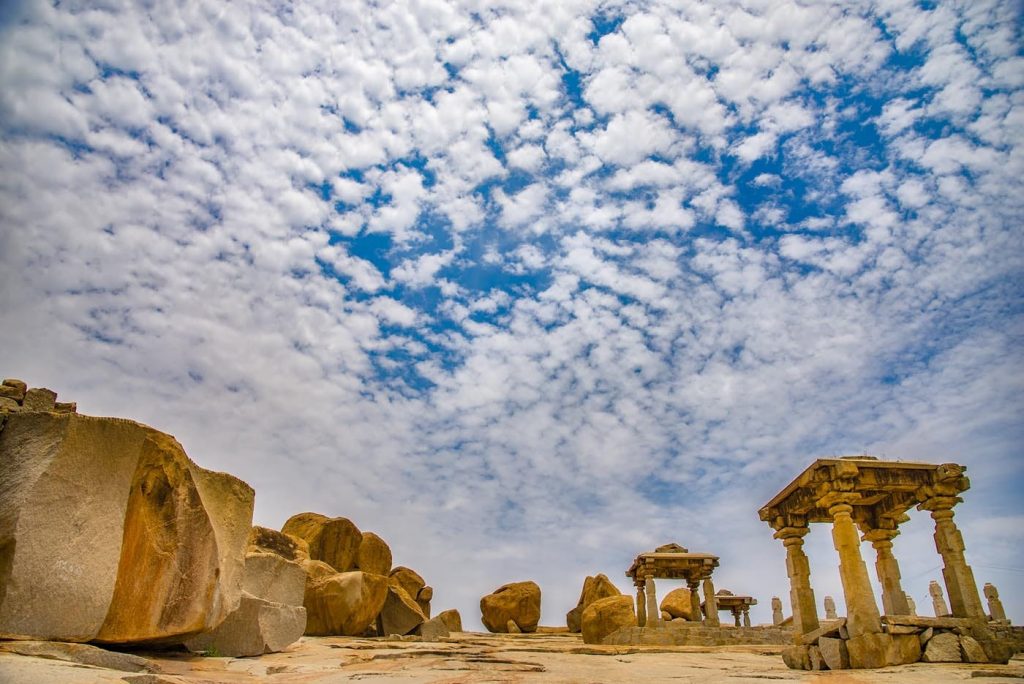

My first idea was to spend two days in Hampi, but I soon realized that a place with such a rich past deserved more time to reveal itself and so I extended my stay in order to fully appreciate the ancient capital. For those who, like me, take the time to walk through the ancient temples, sit beside the appealing carved pillars and admire the incredibly detailed sculptures, it will be like stepping into another era, imagine what life was like when this was a city of glory.
Achyutaraya Temple, for instance, is a vast complex that looks like a lost city itself, hidden in an absolutely beautiful valley dotted with coconut trees (photo on inside front cover). Dedicated to Lord Vishnu, Achyutaraya has a processional alley 330 feet long, a first enclosure with 100 engraved columns and a second yard which is well preserved. The yellow of the stones and the green of the trees are the predominant colors, accented by the brightly colored saris of the Indian women walking here and there, passing from one monument to another, wandering between the columns. As it is not centrally located, fewer people come here, and one can enjoy a more peaceful atmosphere.
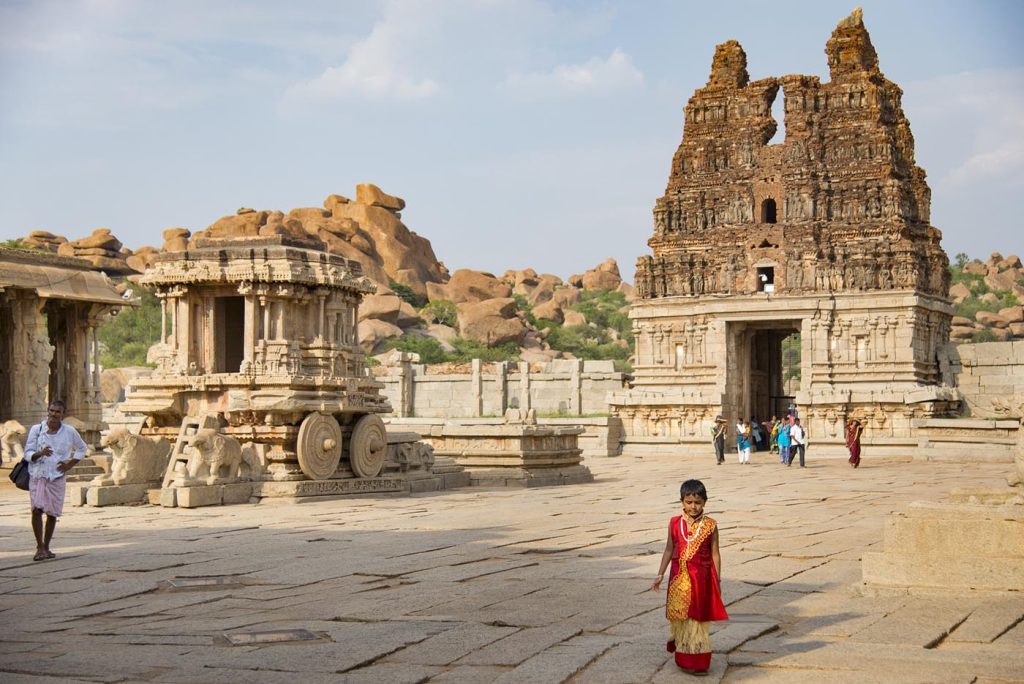

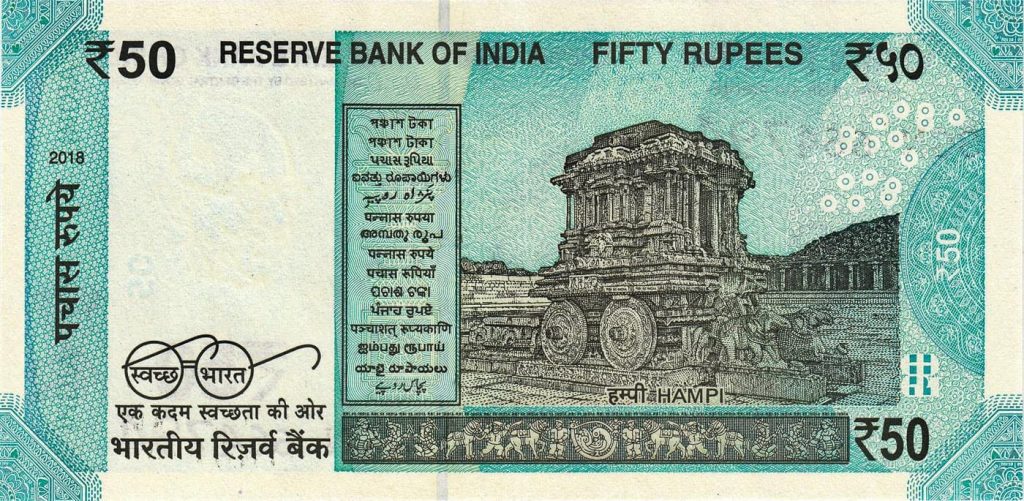

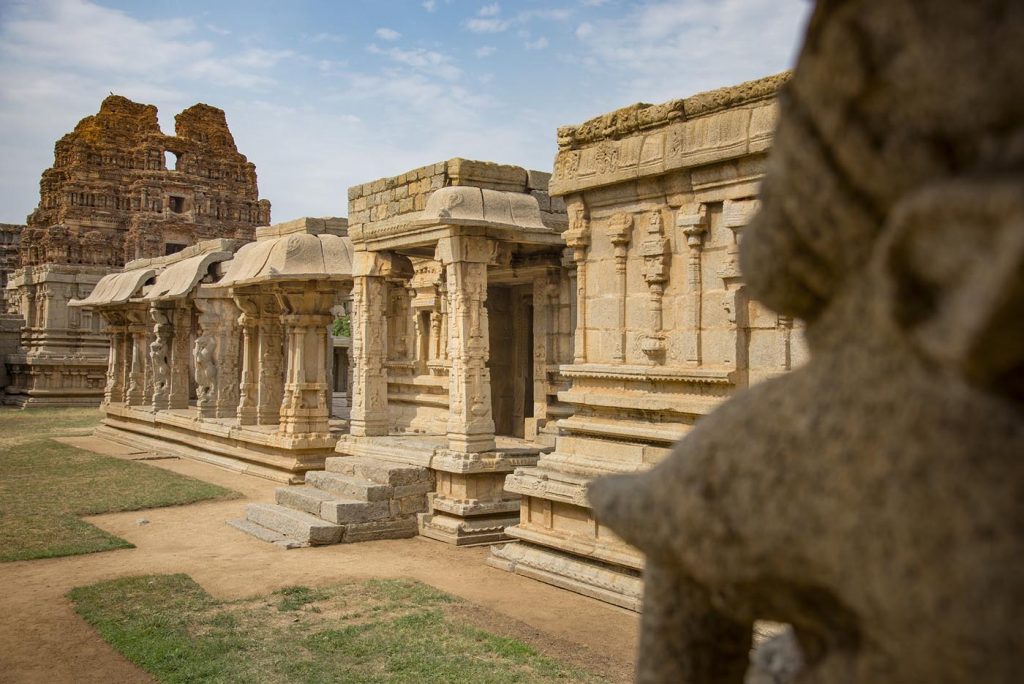

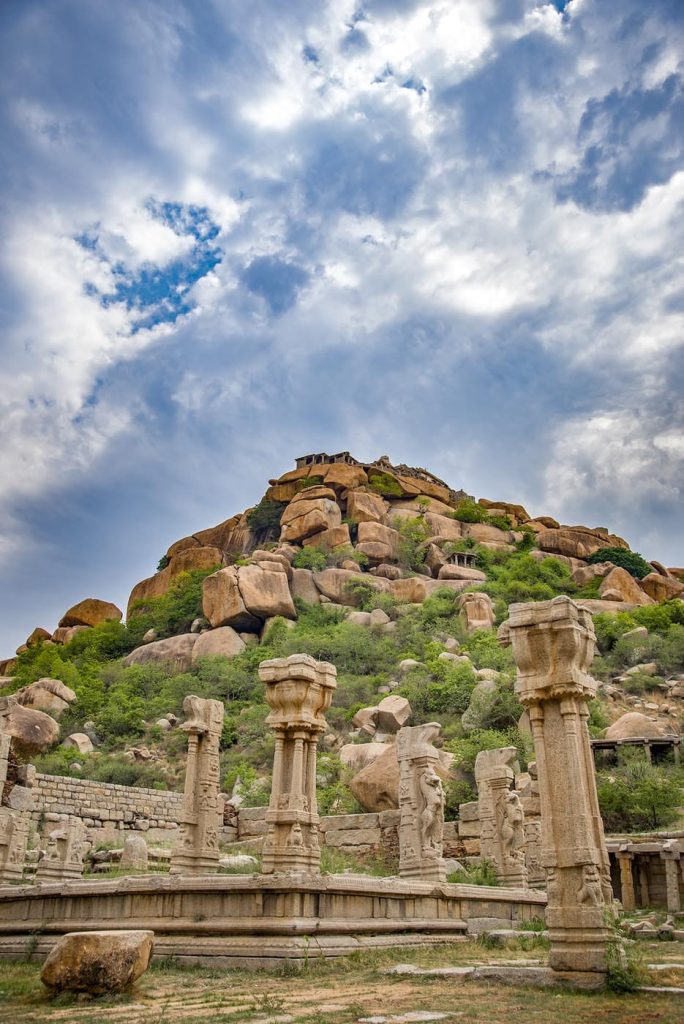

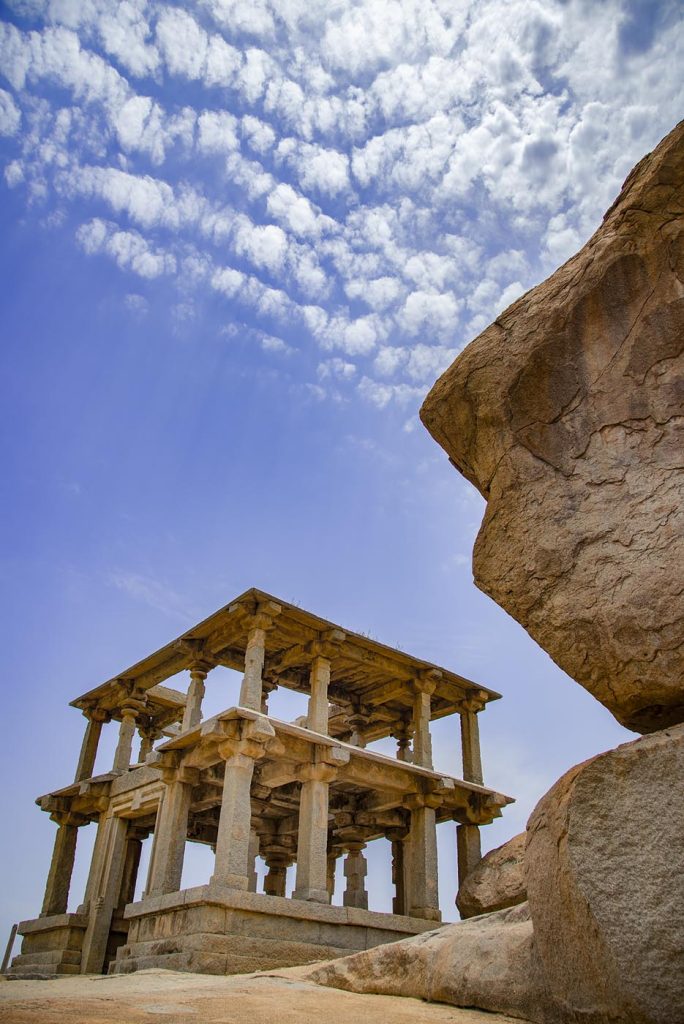

Vitthala Temple, dating from the 16th century, was never fully completed but is one of the richest and most refined temples you can see in the whole site. A stone chariot pulled by elephants is the pinnacle of Vijayanagar art. This chariot, magnificently carved in stone, is the pride of Indians to the point that it adorns the 50 rupee bill. Vitthala has a wealth of other wonders: statues of mythical animals, musical pillars (they produce sounds when struck with the hand), mandapas and a wonderful ambulatory path. Subash, a tourist from Delhi, told me: “Some time ago I saw pictures of the Vitthala Temple in a magazine, and that’s what made me want to visit Hampi. But it is even more amazing in real life. How could they have had such architectural techniques in that epoch?” The best time to discover Vitthala is during sunset, which gives a pinkish shade to the stones and makes the ancient edifice even more magical.
Hemakuta Hill, a vast rocky outcrop with rounded shapes, is another great spot to enjoy the twilight as well as sunrise. From here one can look over the surrounding area and observe the colors of the many stone constructions slowly changing, as if by magic, from yellow to gold. For me, sitting atop Hemakuta Hill, watching the huge fireball slowly descend and disappear behind the horizon was a visual delight and a moment of grace, like when time freezes and the only thing that matters is the present moment. It was a moment I will always remember.
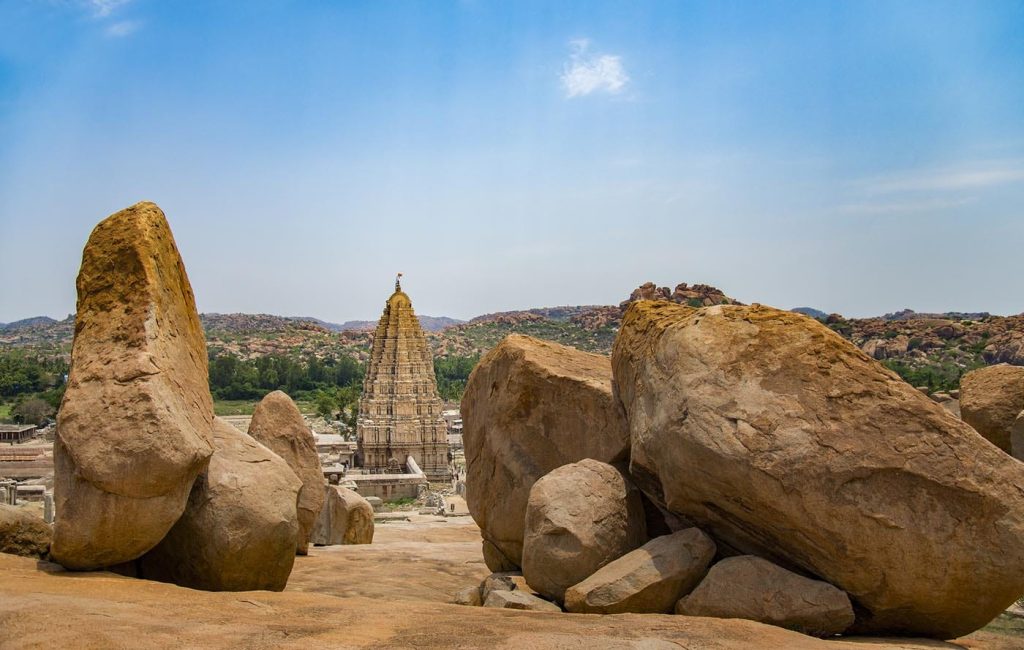

It’s not easy to find your way around in Hampi. The site is so vast, it can be confusing to place the monuments on the map. But it’s worth getting lost and walking for miles to suddenly find yourself in front of one of the grand temples, the Krishna Temple for example. To enter here, one must pass under a huge porch topped by a gopuram. With its richly carved stone walls and colored brick structure, this building is a perfect example of Vijayanagar architecture. Krishna Temple is famous for a specific pillar with carvings of the ten avatars of Vishnu. For me, it was a joy to observe local families wandering around inside the temple. While the men chat with each other, the women keep an eye on their children, for whom the giant statues around which they run or hide constitute the best playground ever.
Speaking of Vishnu, if there is a statue that cannot be missed, it is Narasimha, the largest monolith of Hampi, measuring 22 feet tall. This figure, with a lion’s head surmounted by a beautiful ornate tiara, represents Vishnu’s fourth incarnation. He sits on a seven-headed serpent named Ananta. This massive and well-preserved statue makes children smile, in front of which they love to take selfies. Narasimha was luckier than the sculpture of his wife, Lakshmi, which was unfortunately damaged by vandals.
Finally, there is the Virupaksha Temple. Hampi’s other temples are architectural beauties ruined centuries ago, but this one, built in the 16th century, is still functioning. From morning to night, hundreds of devotees come here daily to honor the Gods. Behind the colossal gopuram, fervent devotees observe an unchanging ritual: passing from courtyard to courtyard, they clap their hands on the granite columns, each of which emits a different sound, then they walk in front of scenes in high relief. When they finally arrive at the sacred Sivalingam, they place a coconut in front of it and receive a blessing from the priest. Inside, drums, chants, incense and oil lamps create an enchanting atmosphere that delights not only innocent visitors, but also the most experienced followers of Hinduism. Every day at 7am and 7pm, a ceremony is held in honor of Goddess Lakshmi, marking the beginning and the end of the day for all. Virupaksha, crowded and noisy, can be a bit exhausting, with people pushing and others asking for selfies, but in the end, it’s a great place to immerse yourself in an grand religious fervor. I enjoyed sitting out of sight, watching the rituals as a delightful way to learn more about Hindu practices.
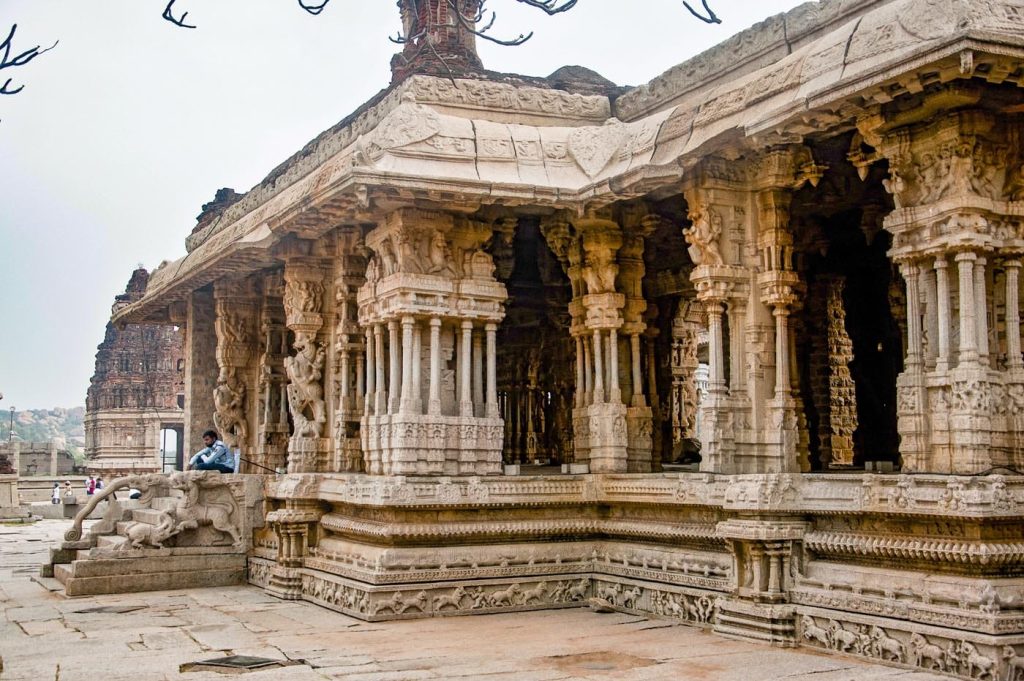

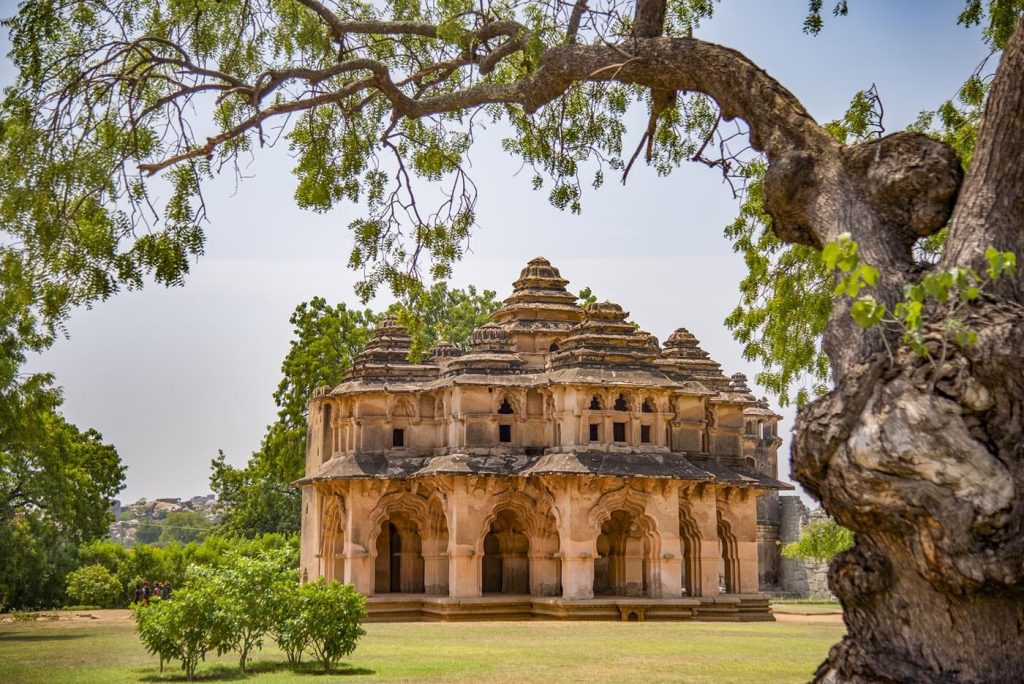

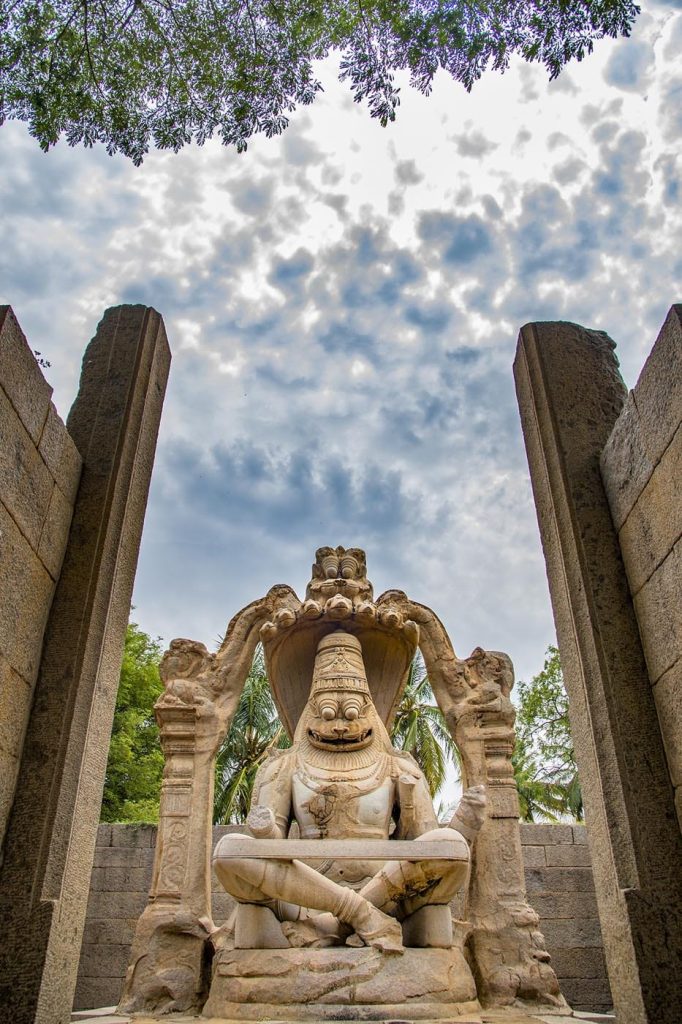



The Secular Section
For the sake of simplicity, the city can be divided into two sectors: 1) the sacred sector, which has the temples, 2) and the secular sector with the royal residence, civic buildings, agricultural land, residential areas, dining halls for royal employees, elephant and horse stables, and markets. New discoveries await us in sector two.
Today, a visitor finds the royal section located in a quiet, bucolic lowland. But centuries ago, it was a bustling place of immense beauty and power. The royal section of the city had gardens, pavilions and step wells. Strolling among these vestiges we can fathom how the palaces and gardens might have looked centuries ago. While discovering the royal section, I met a lovely young couple from Goa who had come to take photos for their engagement. Mala, the bride-to-be, said, “We’ve both been to Hampi before. This place is so full of history, so powerful and romantic at the same time; we really wanted to do these photos here more than anywhere else.”
The Lotus Mahal has survived the disaster of war and time. Known as Kamal Mahal or Chitrangi Mahal, it is located in the Zenana Enclosure, a secluded area for the royal women (harem). This remarkable monument is shaped like a lotus bud, with dome-shaped curving roofs. It is a fusion of Islamic and Dravidian architectural styles. In the short chambers at the base of the domes, one can note small holes, vestiges of a system of pipes that allowed someone to listen to the conversations from the first floor; proof that curious eavesdropping has always been part of human nature!
Not far from the the Lotus Mahal is Elephant Stables, another edifice that is in good condition. With six domes, each a different shape, this building housed the king’s favorite elephants, from a herd numbering up to 800.
The incredible Queen’s Bath with its arches, platforms, aqueducts and balconies where musicians and singers performed, is worth the detour! Thanks to the formidable irrigation system that is still partially visible today, the Queen’s Bath was filled with pure water from a nearby lake.
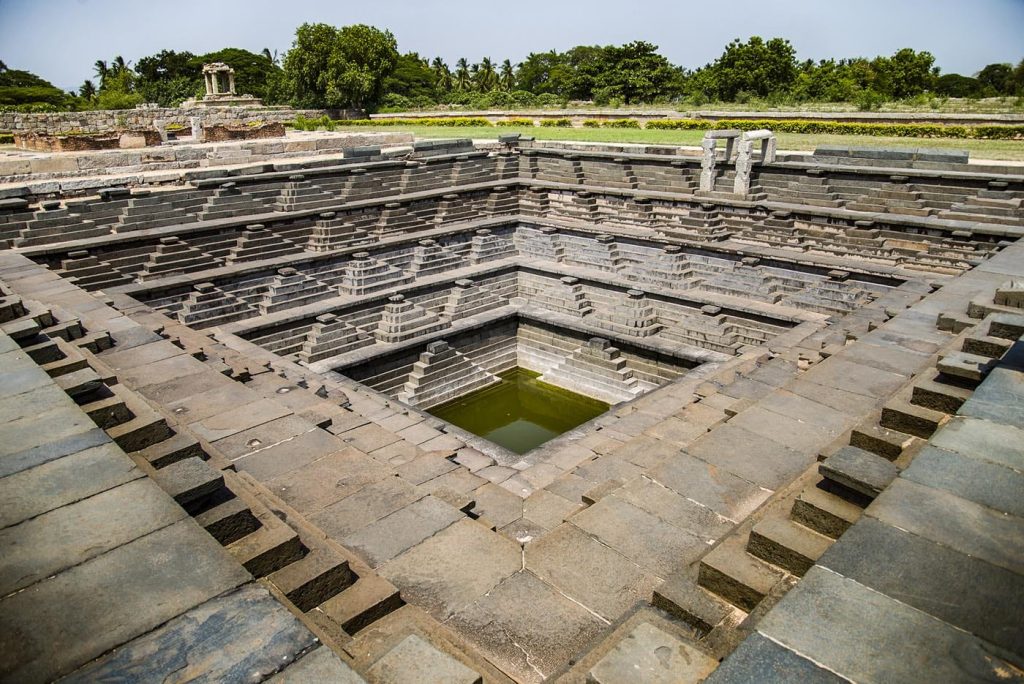

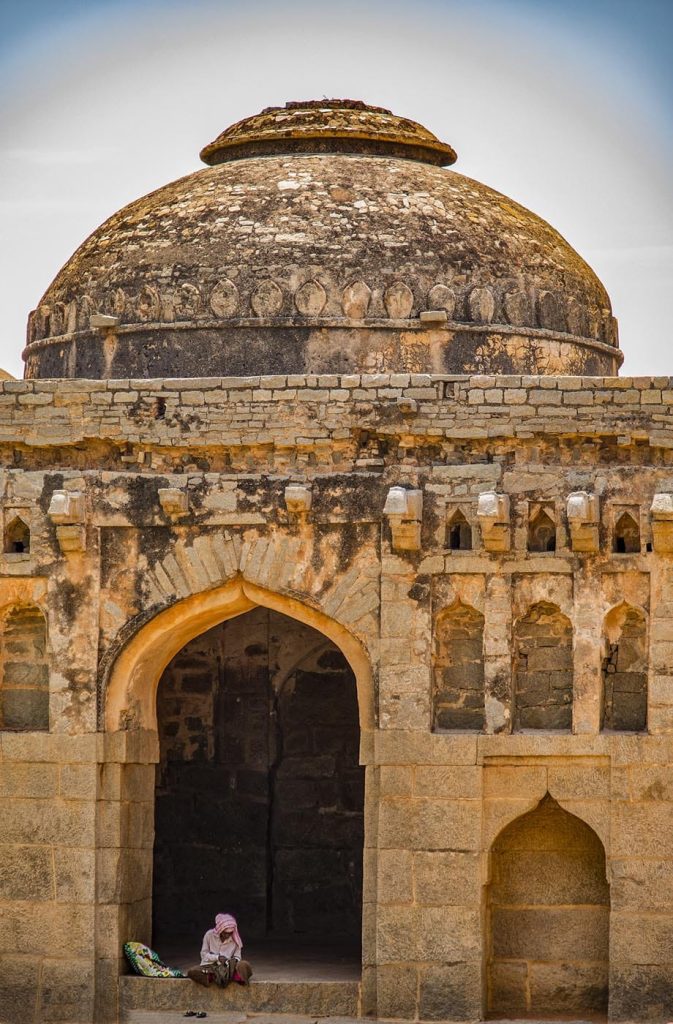

While the nearby Royal Quarters were razed long ago, their remnants give an idea of the centrality and power of the former kings. As for the Markets of Hampi, they were so famous that that merchants from far away traded avidly—precious stones, horses from Persia, spices from the Malabar coast, silk and other goods.
From Oblivion to Rebirth
Hampi went from ancient origins, through a spectacular rise, to an unexpected destruction. In 1565 the Vijayanagara Empire fought a calamitous battle against an alliance of Deccan Sultans. This battle irreversibly changed the course of Indian history and the fate of Hampi. The fertile land of the Krishna and Tungabhadra river basins, the hills, forts and ports controlling lucrative sea routes were of strategic importance to both sides. This was not a battle the mighty Vijayanagara Empire should have lost, but it did. A combination of superior cavalry, firepower and treachery led to the its defeat. Undefended and abandoned, “the impregnable town,” the City of Victory, was methodically destroyed by the invading army. For whatever reason, the winners did not take over and govern the city; instead, they razed it to the ground, torched it and plundered the remaining wealth. A ruined Vijayanagara was left to the vagaries of time, and slowly disappeared from the world stage for over two hundred years.
In 1800 Colin Mackenzie, the first surveyor general of British India, discovered the ruins of the empire. He made extensive use of local informants to gather data, and slowly but surely, Hampi reappeared to the world, but this time as a place of archaeological marvel. In 1986, recognizing their cultural importance to the world, UNESCO declared 68 of the 1,600 monuments as protected, and thus part of Hampi became a UNESCO World Heritage Site.
But preserving Hampi poses many challenges, as it is a living heritage and not a static monument that can be fenced off and protected. The temples and riverbanks are ancient pilgrimage sites. The Dasara festival, which includes Navaratri (nine days dedicated to Goddess Durga), is celebrated annually here, as the royals once did. So, the tradition continues unbroken. Also Hampi has 29 villages, with agricultural and commercial activities close to the monuments.
On my way from one monument to another, I stopped at a sugarcane juice stand for a refreshing drink; a little further I passed stalls selling flashy plastic toys for children; at another corner a man was selling coconuts directly from his truck. I exchanged a few words with a farmer working in his rice field near an ancient monument. All this made me wonder: how can you draw boundaries for a site that covers such a vast area? And how can the rural population around the site live and thrive among ancient ruins? Zoning the land (core, buffer and periphery) and permitting only certain activities appropriate for the zones, and construction without destroying the integrity of the environment are seen as solutions. But the fast development throws another challenge: new construction will impede or make impossible future excavations, as happened in the ancient city of Madurai.


The Indian government’s Department of Science and Technology has brought multi-disciplinary experts for the Digital Heritage Project to create digital installations of heritage sites using the latest technology. The monuments in Hampi are studied and modeled using advanced technologies (3D scanning, modeling, virtual reality, etc.) to create virtual tours as well as to repair damaged structures. Perhaps the past glory of Hampi will be preserved in the virtual world. Replicas of the musical pillars have been created and the roofs of many temples have been restored. But technology does not always have the answer to everything, and the restoration of the Queen’s Bath has been criticized by heritage lovers concerned about the material used. However, these new technologies do allow us to dream of future discoveries that give us more detail about fascinating dynasty of the Vijayanagara kings.
Not only Historical Heritage!
Hampi is known as the largest open-air museum in the world, but not only for its ancient monuments. Many visitors come to discover and appreciate its precious natural heritage, which is quite unusual and very poetic. For those who wish to immerse themselves in the rural Indian way of life, the villages here offer a picturesque setting on the banks of the Tungabhadra River, small hamlets surrounded by vast tracts of lush green farmland.
The river itself is a perfect place to get a glimpse of local life. It’s common to see Indian families sitting on the river ghats, enjoying a gentle cooling breeze, to chat and take a break from their day of work or sightseeing. It was an occasion for me to meet Thiyagu and his family, originally from the state of Odisha. Thiyagu told me: “We love family trips and have visited many places in India, but Hampi is really something special, as there is something for everyone, those interested in history, those who like to spend time in nature, not to mention children who have space to run, play and explore. There is no doubt that it will be in our top three favorite destinations.”
For one who, like me, has always dreamed of being Indiana Jones, the banks of the Tungabhadra River are the perfect place! Here and there are hidden small temples as well as beautiful sculptures of Vishnu or Hanuman, totally neglected by the restoration. Maybe that is not a bad thing, because there remains an impression of authenticity in a mysterious and almost mystical atmosphere. If it is sometimes difficult to say what was the purpose of certain carved blocks, it leaves room for imagination and daydreaming, two words almost forgotten in our ultra-connected and ultra-informed world.
In addition to tourists and budding explorers, rock climbers have also found an excellent playground, with hundreds of large, roundish boulders scattered throughout the area. Animal lovers will be delighted by the amount of wildlife found in these drylands, from mammals to unique bird species. Despite increasing urbanization, the area around Hampi remains a bastion of ecological diversity. The Daroji Sloth Bear Sanctuary, located next to Hampi, offers a great opportunity to observe many species of the scrub forest, a gem of a natural habitat for mongoose, monitor lizard, leopard, sloth bear, pangolin and star tortoise. Hampi and its surroundings are recognized not only by Unesco, but also by BirdLife International—as an “Important Bird and Biodiversity Area (IBA),” where birdwatchers can observe jungle birds, silverbills, shrikes, bush quail and, for the lucky ones, great horned owls and yellow-throated bulbuls.
Hampi and the surrounding region can be visited throughout the year, but the months of April, May and early June, considered the summer period, can be oppressively hot, and the animals are less visible. In June, the rainy season begins, which lasts until August and the rocky landscapes and rice fields are flush with greenery. After the monsoon, the climate becomes gradually more pleasant, for humans as well as animals, and it is a good time to observe the fauna and flora. The choice season extends from November to February. Daniel, an English traveler says: “My first visit to Hampi was eight years ago and since then I have been back several times, always at a different period of the year. Each time I have felt like I was discovering a new place because the nature changes so much depending on the weather and I have noticed that each season has something special to offer, so it is difficult for me to recommend one time more than another. I really think that Hampi deserves several trips so that one can say, “I have seen Hampi, and I know Hampi.’ ”


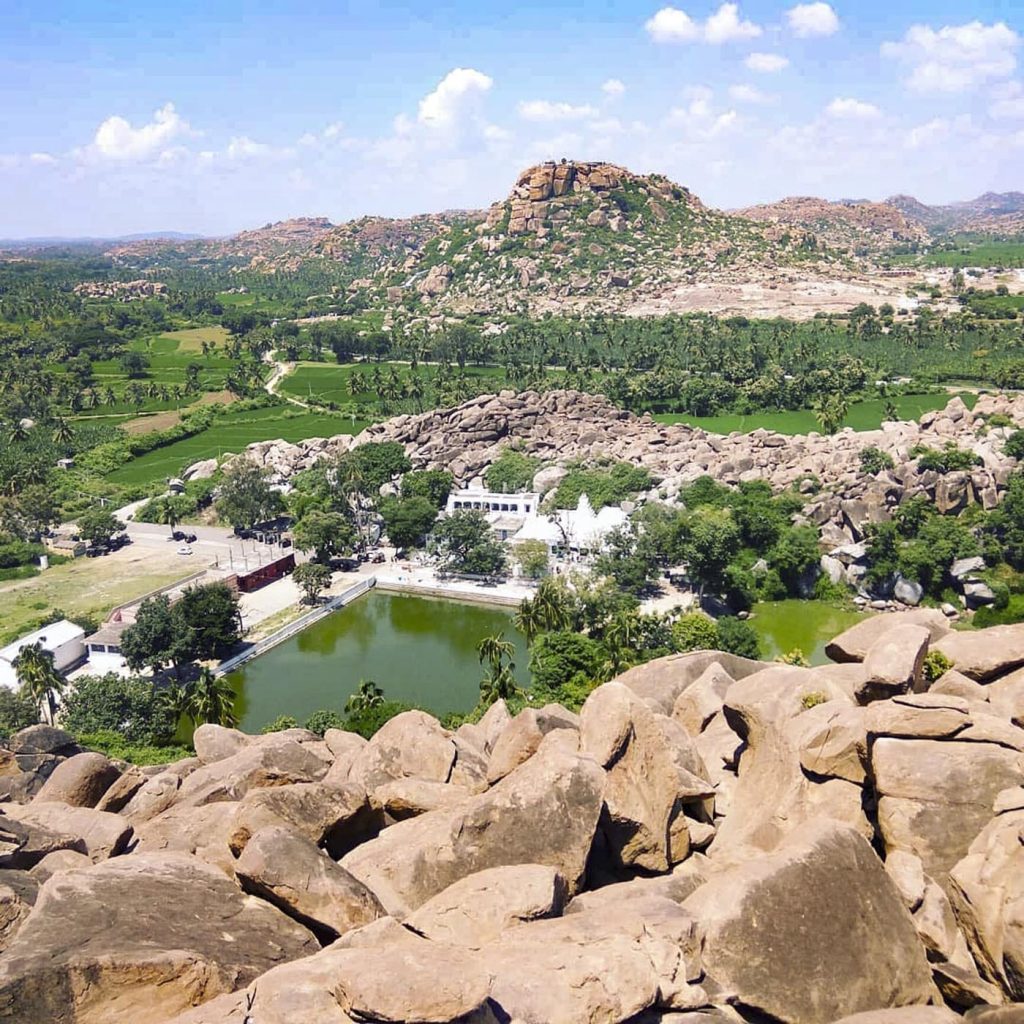

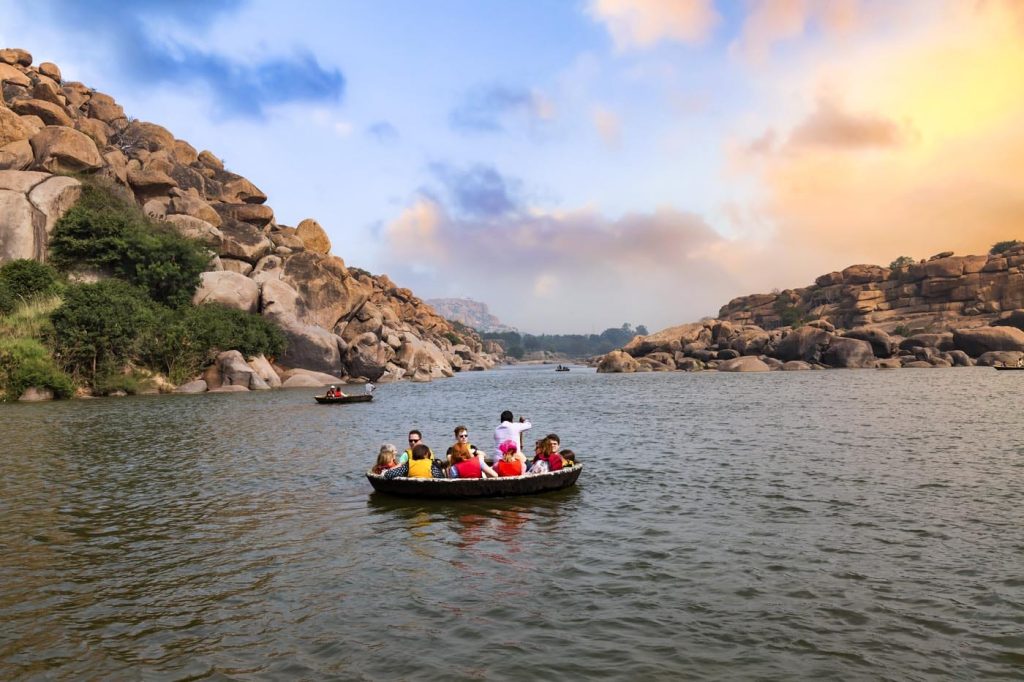

Where to Put Your Suitcases?
With significant marketing and status as a UNESCO site, Hampi is attracting many local and foreign visitors, who, perhaps tired of super touristy Goa, travel 12 hours by bus and put down their bags in the not-so-small village of Hampi. Over the years, the number of guesthouses has increased considerably, but Hampi village remains a better option than Hospet, a medium-sized, rather noisy and uninteresting town. Those who want to spice up their stay a bit and look for a country atmosphere while remaining close to the archaeological site, can stay in the Virupapur Gaddi area, which is reached by crossing a languid river. Another alternative is Anegondi, reached either by an five-mile road from Virupapur Gaddi (by auto-rickshaw, bicycle or motorcycle), or by a small ferry moored about six miles from Hampi. Located in a hilly landscape of rice fields and groves dominated here and there by the remains of temples, Gaddi is an excellent option for those wanting to enjoy nature and history. As I always travel without booking a hostel in advance, I stayed in two different places. Anegondi was undoubtedly my favorite, as it has not yet sold its soul to tourism. Moreover, I felt like I was part of the local daily life by easily meeting the villagers. If you are looking for authentic places rather than trendy ones, consider Anegondi!
Another important tip for travelers who want to cover the entirety of Hampi and get a feel of the surroundings—there are several transportation options: cycling, of course, but also scooters, rickshaws or golf buggies. For my part, I decided to walk or bicycle most of the time. I rented a scooter one day, which gave me a great feeling of freedom and allowed me to see several places in only a few hours. I also hired a rickshaw driver named Phillips, who was a great source of information and always ready to share anecdotes about the temples and the villages we passed.
Hampi is now so used to receiving tourists from all over the world that everything has been put in place to make their stay as comfortable and pleasant as possible. There is something for everyone—you just have to choose!
Conclusion
I now know Hampi is great, spectacular, glorious, majestic, exceptional, amazing and even more. The combination of extraordinary history and breathtaking nature is so uncommon that to discover one aspect at the expense of the other would be to miss what makes Hampi Hampi. Due to the size of the site, the number of ancient monuments and the diversity of the landscape, a trip to Hampi requires time.
While many temples have already been restored, the work of archaeologists continues because many treasures are still buried. Hampi is only slowly revealing itself, still stubbornly hiding some of its mysteries. But even in ruins, any visitor can have the incredible feeling of living the past and can imagine the power that Hampi had when it was still called Vijayanagara. The discoveries that have already been made have greatly changed the situation of Hampi, as well as of all the neighboring towns and villages. Large-scale and rapid development near the protected site, like the construction of bridges, increased vehicular traffic, the proposed reconstruction of the place, facilities for tourists and the effect of industrial pollution on the river, all raise concerns about Hampi’s future. We hope the City of Victory will win over the challenges of the twenty-first century and continue to enthrall visitors for centuries to come. As for me, rather than crossing Hampi off my list of destinations to visit, I wrote it down again and highlighted it because this first trip only piqued my curiosity and I clearly won’t wait centuries before going back!
About the Authors


Padma Krishnan is an independent journalist living in India. A certified hatha yoga teacher, she is passionate about exploring commonalities in ancient mystical traditions.
Anne Petry is a French photographer focusing on Indigenous populations. Her nomadic life takes her all over, from the Shamans in Amazonia to the Hindu priests in India. She is passionate about people who keep alive their beliefs and traditions. Contact Instagram: annepetryphotography




